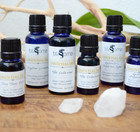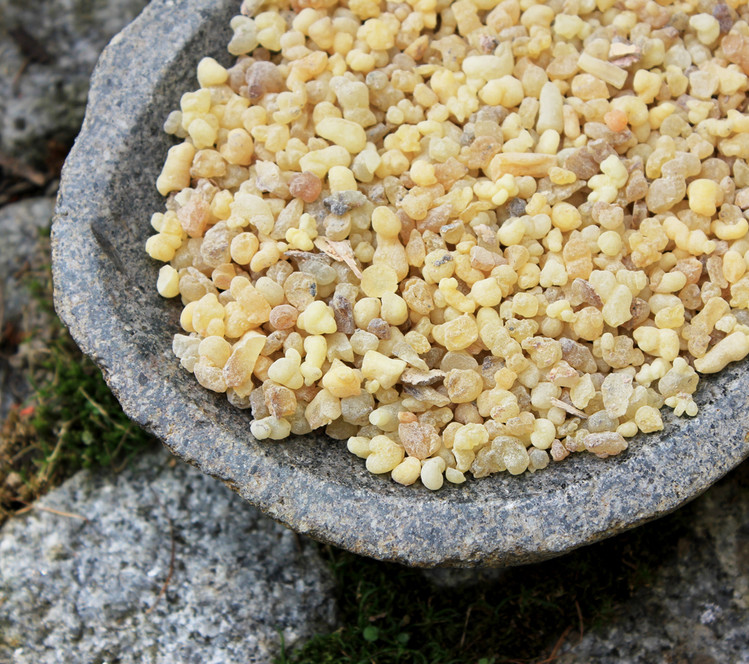Description
Cedrus atlantica - origin Morocco, wood, steam distilledThe Atlas Cedar tree is native to the Atlas mountains of Algeria, and the oil is produced in Morocco. Many people know the aroma of American cedars from chests and exterior construction or perhaps have smelled a Virgina or Texas cedar which are all quite different. The Atlas cedar has a sweeter, more well-rounded woody-balsalmic aroma. While not being as deep as Sandalwood it serves as a reasonable, inexpensive substitute to bring a wood base note into your blends.
The wood has an abundant amount of oil which has a yellow/amber cast to it. It was used by the Ancient Egyptians for mummification due to its antiseptic and preservative qualities. It has also been used as a temple incense. The wood was prized for building because of its insect resistant qualities. The tree can reach over 130 feet in height.
Energetically cedar has a grounding property to it. It is stabilizing and calming without putting the user to sleep. It is often used to cleanse and protect spaces from negative energies. Tree-like qualities include being deeply rooted while reaching skyward. Trees are stable, patient, and enduring. This tree in particular carries its own protection within itself, the oil you can use in your own home and practices.
Atlas Cedarwood essential oil is nontoxic, non-irritant, and non-sensitizing, making it very suitable for skin application. Some sources advise avoiding during pregnancy.
Please see the "Ingredients" tab for the GC/MS test results for this essential oil.
Blending: This oil is considered a base note and/or fixative and will help bind and fix other aromas together. Atlas Cedarwood is very versatile and blends well with citrus oils like bergamot, mandarin, and grapefruit, crisp aromas like cypress, juniper, and rosemary, other base/fixative notes like frankincense, myrrh, labdanum, and patchouli, and florals like ylang ylang. Spice notes like cardamon are also an excellent match.
Blending: This oil is considered a base note and/or fixative and will help bind and fix other aromas together. Atlas Cedarwood is very versatile and blends well with citrus oils like bergamot, mandarin, and grapefruit, crisp aromas like cypress, juniper, and rosemary, other base/fixative notes like frankincense, myrrh, labdanum, and patchouli, and florals like ylang ylang. Spice notes like cardamon are also an excellent match.
Aromatherapy uses: Stress, nervous tension, arthritis and rheumatism, skin applications like acne, athlete's foot, chapped skin, dandruff, eczema, wound care, insect repellent, deodorant
All essential oils bottled by Blissoma come from trusted suppliers that we have worked with for years now for production of our own product line. We are now offering these oils to our retail and professional clients because of their exceptional qualities. Every oil is 100% pure and natural with no adulteration or alterations.
Due to oils being lighter than water 9 g is 10 ml volume (.3 oz). 25 g is about 28 ml volume (1 oz). We are selling by weight because it is more exact.
Disclaimer: Statements made have not been evaluated by the FDA. This product is not intended to diagnose, treat, cure, or prevent any disease.
Directions
Directions for use:Always dilute essential oils properly before use. Base oils and alcohol are both good for dilution.
Dilution rates will vary by age of the individual and application of the oil.
.25% - for children 3 months to 2 years
1% - for children 2-6 years, pregnant women, and individuals with challenged or sensitive immune systems, and facial use
1.5% - children ages 6-15
2% - for most adults for general use
3%-10% - focused use on smaller areas of the body for therapeutic purposes
10-20% - perfumery level dilution, for small areas of the body and very temporary use on larger areas such as muscle injury
6 drops of essential oil per 1 oz carrier oil is a 1% dilution
12 drops of essential oil per 2 oz carrier oil is a 2% dilution
If irritation occurs discontinue use. Keep essential oils stored in a cool location out of sunlight to best preserve them.
Ingredients
GC/MS Test Results for this essential oil| Himachalene <alpha> | 45.41 |
| Himachalene<beta> | 16.55 |
| Himachalene<gamma> | 10.28 |
| Altanone | 3.89 |
| Neoisolongifolene<8,9-dehydro> | 2.14 |
| Deodarone | 2.13 |
| Deodarone | 2.13 |
| Ar-Tumerone | 2.13 |
| Cadinene<delta> | 2.1 |
| Himachala-1, 4-diene<11aH> | 2.04 |
| Himachalene <a-dehydro-ar> | 1.29 |
| Acorneol <alpha> | 1.16 |
| 4-Acetyl-1-methylcyclohexene | 1.03 |
| Bisabolol <alpha> | 0.93 |
| Tumerone isomer | 0.88 |
| Altanone isomer | 0.78 |
| Bisabolene isomer | 0.75 |
| Calacorene <alpha> | 0.7 |
| Gurjunene <alpha> | 0.69 |
| Cubenol<1-epi> | 0.65 |
| Isolongifolene<4,5-dehydro> | 0.63 |
| Himachalene isomer | 0.57 |
| Longifolene | 0.55 |
| Cycloisolongifolene | 0.48 |
| Neoisolongifolene isomer | 0.44 |
| Himachalene isomer | 0.43 |
| Longipinocarveol, trans- | 0.43 |
| Longifolene isomer | 0.33 |
| Longifolene isomer | 0.28 |
| Longiborneol | 0.28 |
| Cedrene<alpha> | 0.21 |
| Dehydrosisolongifolene isomer | 0.17 |
| Bicyclogermancrene | 0.17 |
| Calamenene<cis> | 0.11 |
| Himachala-1,4-diene isomer | 0.09 |
| Acetophenone<4'-methyl-> | 0.08 |
| Longipinene<alpha> | 0.07 |
| 1-(4-Methyl-3-cyclohexen-1-yl) ethanol | 0.05 |
| 3-Penten-2-one, 4-methyl- | 0.03 |
| Pinene<alpha> | 0.03 |
| Terpineol <alpha> | 0.03 |
| Limonene | 0.01 |












